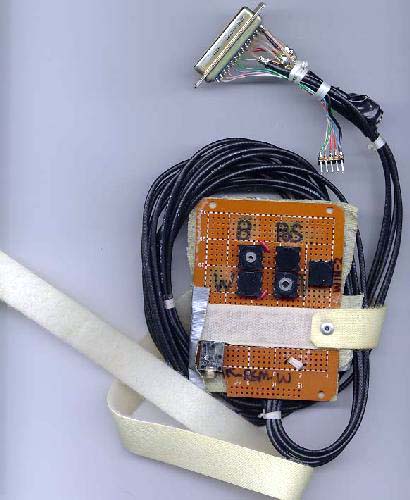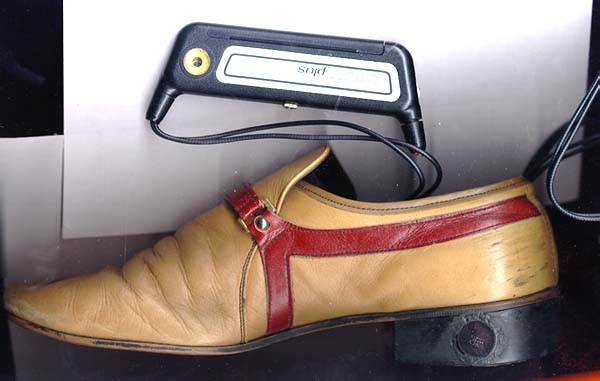~@Com~
Since 1994
AUG 1997; update MAY 2011Links: Photo Gallery | Blackjack Project | Roulette Project | Roulette Timing | KIM-1 (6502)
~@Com~
Since 1994
AUG 1997; update MAY 2011Links: Photo Gallery | Blackjack Project | Roulette Project | Roulette Timing | KIM-1 (6502)
Our files are of the format shown below. One sample trial is shown here. Our data contain many trials but only one trial is shown in Table 1 below as illustration. The data were collected circa 1984. The files, or datasets, contain
|
|
Ball and Rotor (Wheel) timings, the winning pocket number [WON] in which the ball landed in the trial; the (elapsed) time at which the ball landed; the observed "would-have-landed" pocket [WLD] if there had been no "bounce" of the ball; and the predicted winning pocket, using our algorithm [running on Radio Shack's PC2 computer]. Our algorithm was based on the assumption that the decay of the ball is a 2nd degree polynomial. We determined by measurement that the decay of the rotor is, for all practical purposes a straight line.
The constants a, b and c, for a 2nd degree polynomial (y = ax^2 + bx + c ) were determined empirically, by timing the ball, prior to play. We gathered data in files which contain only BALL timings. These data were gathered over a period of several hours prior to play and were then analyzed using curve fitting routines. There routines determined the constants a, b and c for the polynomial above.
Some of the files we have contain only Ball data -- ball revolution times with the winning pocket number. Some files contain the rotor revolution times and additional items.
The BALL and ROTOR (We also use the term "WHEEL" for ROTOR) were timed against an arbitrary spot on the the rim of the roulette wheel (12 o’clock position).
 Datasets of the format shown
below contain timings of the ball and the wheel; similarly
formatted datasets contain only timing of the ball. (Ball timings
were deemed most important to analyze; we discovered that
ROTOR timings, even over very long times, were quite steady -- the
decay of the wheel was very regular and almost linear.
Datasets of the format shown
below contain timings of the ball and the wheel; similarly
formatted datasets contain only timing of the ball. (Ball timings
were deemed most important to analyze; we discovered that
ROTOR timings, even over very long times, were quite steady -- the
decay of the wheel was very regular and almost linear.
Numbers shown in array #1 (wheel) and array #2 (ball) represent time for one revolution, in milliseconds. The timing of the ROTOR (array#2) started the clock running; all other times are relative to this start time.
Although the BALL times appear first in the array, they are captured AFTER gathering the ROTOR times.
After the croupier launched the ball, the ROTOR times were gathered first. This allowed the ball to dissipate some energy. In most cases, the staring of timing the ROTOR is indicated by the "1" in the ROTOR data (array#1). In some cases, if many ROTOR times were obtained, only the latest times were saved in array#1. The array elements were pushed up, and the earliest clock times were pushed off the top of the array; thus "1" may not always appear as the first entry in array#1.
The same "push-up" principle is in effect for array#2, (the timing of the BALL); popping old timings off the top of the array preserves the latest timings and discards the oldest ones.
For BALL and ROTOR clock times, subtract successive clock-times to obtain revolution time (in milliseconds). The last entry in the Ball array usually represents only a partial revolution of the BALL, since this is the time when the ball entered a pocket (or was deflected by a pocket partition).
In the case of deflections by pocket partitions or "diamonds", we believe our data also shows the pocket in which the ball would have landed if no deflection had occurred. Our data are 13 years old, at time of this writing, and this is, to the best of our recollection, what data element #17 in the arrays means.
Each trial is terminated by a calculating a checksum [CKSUM - below].
|
# |
Time |
The ball and rotor are "on the same clock" |
||
-Ball- |
Array #2 |
1 |
0 |
Time when the BALL passed a fixed location going in |
|
|
2 |
0 |
the opposite direction of Rotor. Entries bubbles up to take in |
|
3 |
6122 |
<-- New times collected. The last location (#8) contains the |
||
4 |
7116 |
'touchdown time' - the time the ball landed in the wheel. |
||
5 |
8260 |
As new times are entered, the array may be rolled |
||
6 |
9569 |
toward the top for a maximum of 8 for the ball. |
||
7 |
11116 |
<-- Last time for a full revolution. | ||
8 |
12665 |
<-- Time the BALL landed - usually not a complete revolution. |
||
-Rotor- |
Array #1 |
9 |
0 |
Each of these six values represent a time when the "00" location on the rotor passed a fixed point on the rim. The clock always starts with '1', which is captured at the first press at time zero. As new times are entered, the array is rolled up one location to a maximum of 6 for the rotor (wheel). |
10 |
0 |
|||
11 |
1 |
|||
12 |
1590 |
|||
13 |
3163 |
|||
14 |
4782 |
|||
|
|
Observed results and predicted winning number |
|||
[WON] |
15 |
4 |
The actual winning number. |
|
[LND] |
16 |
10 |
The clock position in which the ball landed. |
|
[WLD] |
17 |
8 |
Estimated-observed "would-have-landed" if no bounce??? |
|
[PC2] |
18 |
32 |
Predicted winning number using our PC2 computer. (Wrong!) |
|
[CKSUM] |
19 |
64438 |
Checksum - sum of above 18 numbers. |
|
| Table 1 | ||||
Data were gathered using American wheels having 00 and 0 pockets. All trials were conducted on roulette wheels in which the ball was spun in the clockwise direction, and the rotor in the opposite direction. Atmospheric pressure and ball diameter and condition were not noted. The sex if the croupier was not recorded.

One experimenter's shoe. An infrared
receiver is |
Our data files probably cannot be combined for analysis. They represent individual sessions with specific wheels. We do not have information that shows which data files were collected on the same day, with the same ball and wheel, the same croupier, etc.
The data element [WON] may appear in a converted form on some files. A conversion table is shown here. The for each wheel pocket number in the first column, the corresponding clock position is shown the third column. The sequential order of the pockets is shown in column two. Converted data is recognizable by the two-decimal figures. For example, 6.95 represents a clock-position on the rim of the roulette wheel where the ball landed (roughly at seven o’clock; this represents a winning pocket numbered 9).
These data are available for your analysis. Please let us know something about your project and use of the data.
We are interested in any insights recipients of these data can provide. We are interested in neural net analyses of these data. We thank you kindly in advance for your input and cooperation.
SAMPLE DATA
--------------- Trial starts here---------------------
See
Table 1
above for the format of these data.
0
0
0
7024
8242
9702
11437
12060
0
1
1465
2981
4506
6026
10
6
8
35
63503
0
0
5435
6580
7874
9398
11254
11856
0
0
1
1600
3273
4966
7
3
6
28
62281
0
0
0
6162
7404
8867
10676
11454
0
1
1493
2995
4484
5978
3
4
3
13
59537
0
0
0
5678
6942
8430
10208
11001
0
0
1
1752
3528
5289
14
4
14
33
52894
0
0
0
5703
6938
8377
10149
10725
0
0
1
1522
3057
4614
2
3
6
0
51097
0
0
0
5908
7068
8430
10006
11352
0
0
1
1710
3462
5182
4
7
10
29
53169
0
6642
7596
8699
9996
11514
13423
13789
0
1
1277
2551
3808
5128
4
1
3
30
84462
0
0
5057
6068
7201
8516
10040
11515
0
0
1
1364
2745
4126
10
9
10
2
56664
Raw data are available -- email your request and tell me what you are going to do with it! Contact
Links:
Pictures from our roulette prediction
project
Roulette Project Images
Photo Gallery
CONVERSION TABLE
The predicted time of touchdown is mapped
to the sequence number of the rotor's pocket
(slot) and clock position on the roulette wheel.
This table translates the sequence of each
pocket to the pocket location.
Slot/Pocket # Seq. # Clock Pos.
Table 2
Just for fun, here is a link to a web
page which lets you write programs
in AppleSoft BASIC.Basic is what we used to analyze our
Roulette data on the Apple II.
© 2015 All Rights Reserved. ~~Page by @Com~~ updated 07/22/15